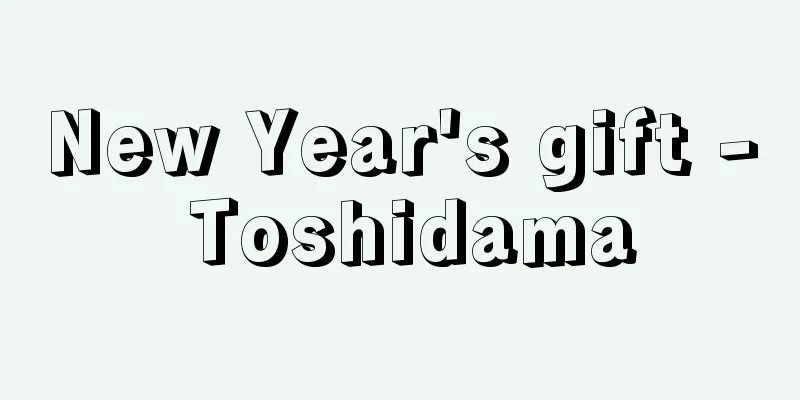New Year's gift - Toshidama

|
This term generally refers to gifts given to celebrate the New Year, but in recent years it has come to mean only pocket money given at New Year. The custom of giving gifts at New Year can be traced back to the Middle Ages, but in early modern documents, names such as tosidama silver, tosidama fan, and tosidama medicine appear. Tosidama silver was money given as a New Year's gift, tosidama fan was a fan given as a gift by townspeople, and tosidama medicine was called tosidama gan, a crude pill given out by doctors. Thus, in early modern towns, there was a tendency to specify the items given as tosidama, but nationwide, mochi (rice cakes) were the main item. Among the New Year's mochi, the custom of making small mochi for each family member, putting them on the shelf, and eating them as zouni (a soup made with rice cakes) still remains in various places. These tosidama symbolize the arrival of the new year and the addition of another year. In the coastal areas of Shimane Prefecture, it is said that the god of the New Year comes to distribute tosidama on New Year's Eve. Also, on Koshiki Island in Kagoshima Prefecture, an event is held in which young people dressed as Toshidon (New Year's Deities) visit homes and give children rice cakes as New Year's gifts. In many regions, these rice cakes are called Fukude, Tamashii, or Miiwai. As all of these represent one's own spiritual power or vitality, it has been believed that eating New Year's gifts will replenish weakened spiritual power and vitality. [Masaru Sasaki] Source: Shogakukan Encyclopedia Nipponica About Encyclopedia Nipponica Information | Legend |
|
新年を祝う贈答品一般をさす語であるが、近年はとくに正月に与える小遣いの意に限定されつつある。新年に際しての贈答慣行は中世までさかのぼることができるが、近世の文献には年玉銀、年玉扇、年玉薬(ぐすり)などの名称がみえる。年玉銀は年玉としての金銭、年玉扇は町人らが贈り物とした扇、年玉薬は年玉丸(がん)ともいって医者が配った粗製の丸薬である。このように、近世の町場では年玉の品物が特定する傾向もあったが、全国的には餅(もち)がその中心である。正月の餅のなかで、とくに家族の数だけの小餅をつくり、それを年棚にあげて雑煮(ぞうに)にして食べるといった慣習はまだ各地に残っている。新しい年を迎えて歳(とし)を一つ重ねることを、こうした年玉が象徴しているのである。島根県の海岸部では、大晦日(おおみそか)に年神様が年玉を配りにくると伝えている。また、鹿児島県の甑(こしき)島ではトシドン(年殿)に扮(ふん)した若者が戸別に訪れて、子供に年玉の餅を与えるといった行事が営まれている。こうした年玉としての餅をフクデ、タマシイ、ミイワイとよぶ地方も少なくない。いずれも自身の霊力や活力を意味することから、年玉を食すことによって、弱った霊力や活力を更新すると考えられてきた。 [佐々木勝] 出典 小学館 日本大百科全書(ニッポニカ)日本大百科全書(ニッポニカ)について 情報 | 凡例 |
Recommend
Heteropore
…Akinete are specialized cells for asexual reprod...
Aida
They gather together and hunt. See the entry for &...
Anabaptist - Anabaptist
→Anabaptists Source: Shogakukan Encyclopedia Nipp...
Antonine Cross - Antonine Cross
… [Tatsuya Moriyasu] [Images] Anthony is depicted...
Common Kestrel (Chogenbo) - Common Kestrel
A species of bird in the Falconidae family, or a g...
Amarbayas French Heat - Amarbayas French Heat
...Located in Selenge Aimak in north-central Mong...
Welles, Orson
Born May 6, 1915 in Kenosha, Wisconsin [Died] Octo...
Marine Corps - Kaiheitai (English spelling) Marine(s)
The military branch whose main mission is amphibi...
X-ray tube
An electron tube for generating X-rays. It has a ...
Clive, Robert, Baron Clive of Plassey
Born: 29 September 1725, Staich, Shropshire [Died]...
Benedict Carpzov
1595‐1666 A jurist who represents the establishmen...
Street lamp - Gaito
〘 noun 〙 Electric lights installed to illuminate t...
Climate and soil type
… [Major soil types in the world] Soils can be br...
Granulosa lutein cells - Lutein cells of the granulosa
…After ovulation, the follicle becomes loose and ...
Sicista betulina (English spelling)
…[Yoshinori Imaizumi]. … *Some of the terminology...









